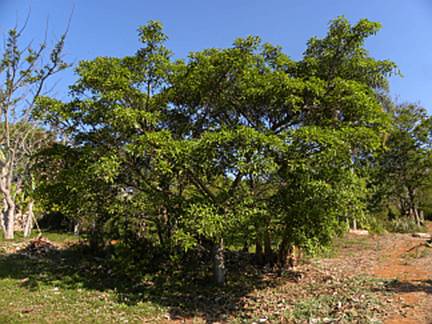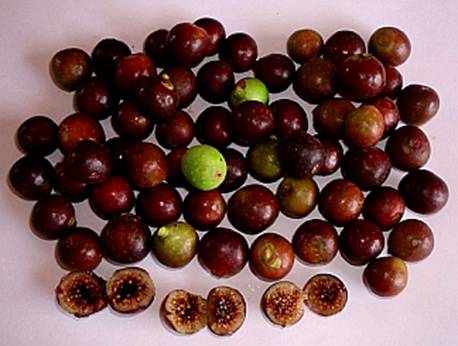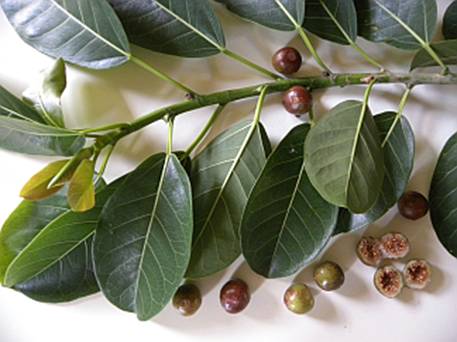FICUS ENORMIS and FICUS LUSCHNATHIANA
FAMILY OF MORACEAE
|
|
|
|
Tree |
Fícus enormis, ripening fruits |
|
|
|
|
Fruits of Fícus enormis |
Leaves and fruits of Fícus luschnathiana |
NATIVE NAME: CAXINGUBA-Í comes from the Tupi Guarani and means “tree which gives syrup or medicine against worms" and the adjective I is belittling, indicates the size of the leaves or the fruits. Both species are also called as Figuinho do mato, Figueira mata pau, figueira doce or da pedra genannt.
Origin: Both species are found in semi-evergreen forests, especially near streams or in secondary moist soil in its natural state from Minas Gerais and Epírito Santo to Rio Grande do Sul in Brazil. More information in Portuguese at the link:
Features: 5 to 16 m tall tree with a thick trunk and broad with large buttresses at the base, at the age it will form roots as a quest. The crown is tightly and measures 8 to 25 m of diameter. Plenty of latex will flow out of the trunk, if the trunk gets hurt. The bark is gray and smooth with gray markings and horizontal lenticels (warts). The leaves are concentrated at the top of the branches and are simple, bare (hairless). Both sides, coriaceous, lanceolate, oblong (longer than wide) and the new leaves have downy ribs (almost invisible soft hairy). The leaf blades measure 4 to 23 cm long and 3-7 cm wide, the base is sharp, blunt, or truncated (cut off), the rounded or pointed tip. The vegetative shoots of the branches are protected by reddish green or rarer becoming green, spade-shaped, 1.5 to 2.5 cm long stipules (type of modified leaf). The fleshy hollow capsules are spherical with an apical foramen and the flowers are on the interior walls, where the seeds are formed, they are formed in the leaf axils in pairs. The fruit measures 1 to 2 cm of diameter.
Notes: The species Fícus luschnathiana is very similar to Fícus enormis and should be by my opinion one variety of Fícus enormis. This difference is primarely by green shoots, leafes with rounded top and a bit larger fruits during F. enormis has leaves with shorter stalks and dark red and smaller fruits.
Culture tips: Grows quickly and can be grown everywhere in Brazil, is adapted to temperate, subtropical and tropical regions, where the average temperature is 13°C to 26°C, withstands frosts of up to -5°C. It can be grown from 5 m to 1,650 m above sea level, prefers over the year distributed rainfall from 770 to 2500 mm. It grows on all soils that have profound and good moisture retention capacity. It also grows on sandy soils on river banks and in red soil and the best pH for good fruit set should be between 5.5 and 6.7. The fruiting begins at age 2 to 3 years.
Propagation: The seeds are tiny and the rotten fruits should be distributed on the surface of the boxes (40 cm long, 20 cm wide and 15 cm high) and covered by a thin layer of sifted organic material. Germination usually takes 30 to 40 days and is then almost complete. And the seedlings should be transplanted into individual bags when they are 10 cm high and the substrate should be moist. After transplanting, the seedlings should be in full shadow and should be watered every day more or less. When planting them in full sun they should have reached after 6 months a height of 30 to 40 cm. The compost used in the individual pockets should be consist of 50% of organic and tanned constituents, 20% sand and 30% of soil.
Planting: They should be planted in a distance of 6 x 6 m. The planting hole should measure 50 x 50 x 50 cm, should be filled 30 cm high of 6 well mixed shovels of manure, lime 500 g and 600 g ash. After the mixture is homogeneous, to act for 2 months a year. The best time to plant is during the months of September and October. Once water generous per week in the first 2 months, and then only if the moisture is lacking.
Culture: Shape cut of the crown and removing the shoots that grow from the base of the trunk. Fertilize with organic compost, can be organic compost to 6 kg + 50 g of NPK 10-10-10. Double the amount every year until the third year, then the simple set. Irrigation at the time of flowering and fruiting increases productivity and quality of fruit.
Use: Bears fruit in the months of October to February. The fruits can be eaten in kind and are very tasty. They can also be used as juices, jellies and ice cream. The tree should not be missing in the kitchen garden and planting in the city, since its fruits attract and feed dozens of species of birds.
Back to the seedlist (English) or back to Moraceae (Portuguese)



